![]()
Seven decades after his grandfather – the seminal Indian modernist painter Francis Newton Souza – left his homeland to live in London, Paris, and eventually New York, the brilliantly talented Israeli-British-Goan muralist and painter Solomon Souza arrived in Goa for the first time in mid-November 2019.
At 26, already internationally renowned for spectacular street art portraits painted in tribute to heroes and figures of repute, he set about to create 20 larger than life murals of relatively unsung icons on walls around Goa as part of the ‘Icons of Goa’ series for the Mundo Goa project curated for the Serendipity Arts Festival by Vivek Menezes.
This Sunday morning, I set out to find and photograph all 20 Icons that have been painted around Panjim, Saligao, Aldona, and Pomburpa. The curators’ creation of a Google map location for the Icons of Goa came in helpful.
You can follow the route I cycled on Strava: https://www.strava.com/activities/4709423215
Google locations of the murals: https://goo.gl/maps/e9AM51hNwUu5eBNu6
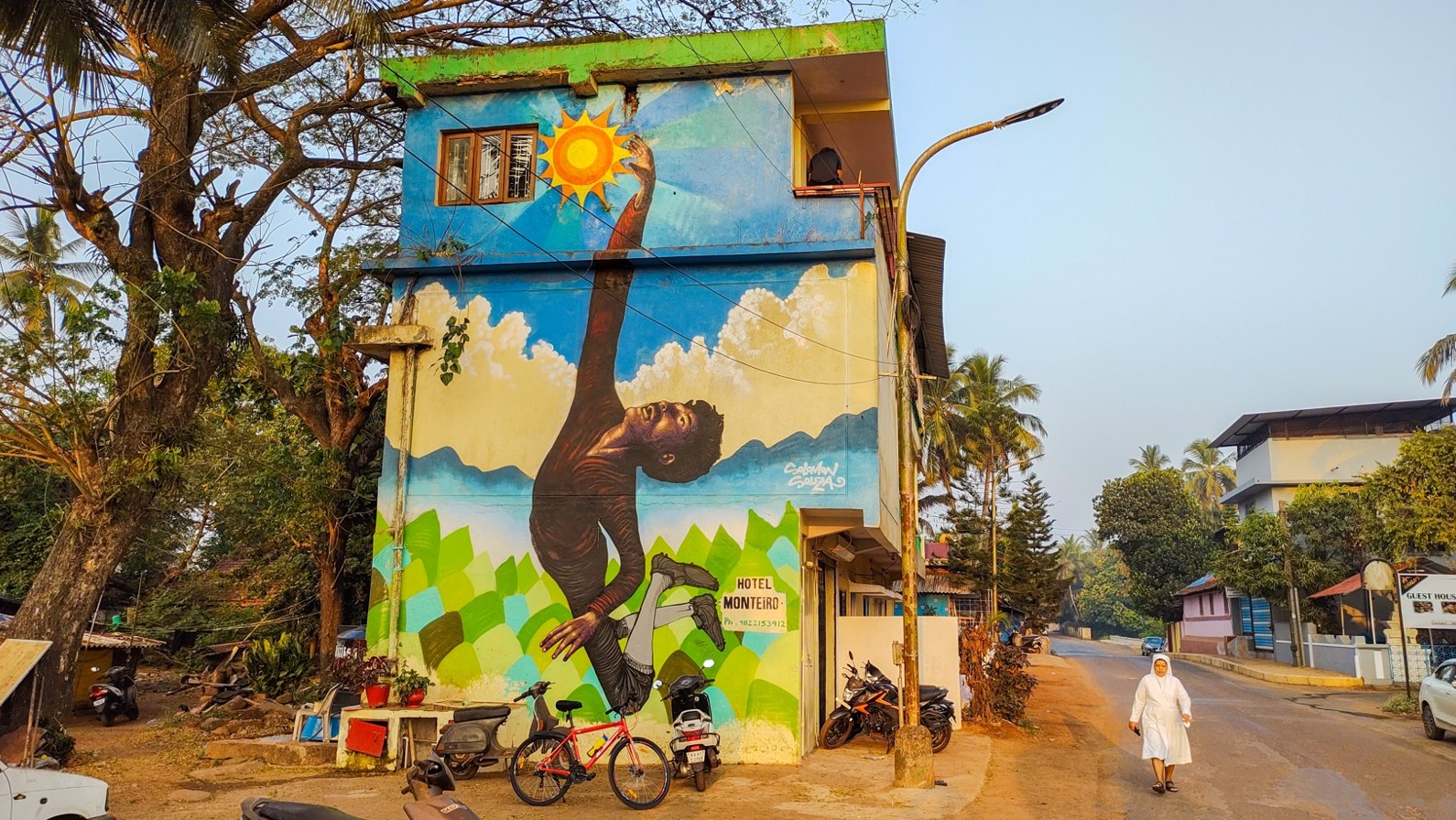
My first stop: Taleigao, where a mural of my boyhood idol was painted.
1. Brahmanand Sagoon Kamat Sankhwalkar
Brahmanand, regarded as one of India’s finest goalkeepers, had a 25-year playing career, captaining the Indian team from 1983 to 1986. The painting honours this legendary goalie, whose exploits have given many of the best moments in Goa’s long history of love for the beautiful game! For example, in 1983, Brahmanand captained Goa to the Santosh trophy with an unrivalled record performance, surrendering precisely zero goals throughout 576 minutes, spanning every game from the first round all the way to the final!
Read more: Brahmanand Sankhwalkar
Location: Hotel Monteiro, Taleigao

2. Reita Faria
The mural of Reita Faria, the first Asian woman to win Miss World, can be seen in the Campal’s heritage area. Reita won the coveted title on November 17, 1966, in the 16th edition of the pageant held in London, defeating 51 other delegates from different nations. During the competition, she also won the sub-titles of ‘Best in Swimsuit’ and ‘Best in Eveningwear’ (for which she was draped in a beautiful saree).
Read more: Reita Faria
Location: Behind Tarini Store, next to Directorate of Health Services, Panjim

3 & 4. Anthony Gonsalves & Lata Mangeshkar
A short ride away at the Maquinez Palace, Solomon paid tribute to two very great Goan icons in a lovely moment in musical history that occurred in 1958, when the brilliant Anthony Gonsalves conducted his pioneering Indian Symphony Orchestra in a concert at St. Xaviers College in Bombay, showcasing the unforgettable voice of his lifelong friend, Lata Mangeshkar.
Read more: Anthony Prabhu Gonsalves
Due to ongoing renovations at Inox, a big electrical box has been put in front of the mural; perhaps, it will be removed shortly. Below image I download from the internet.
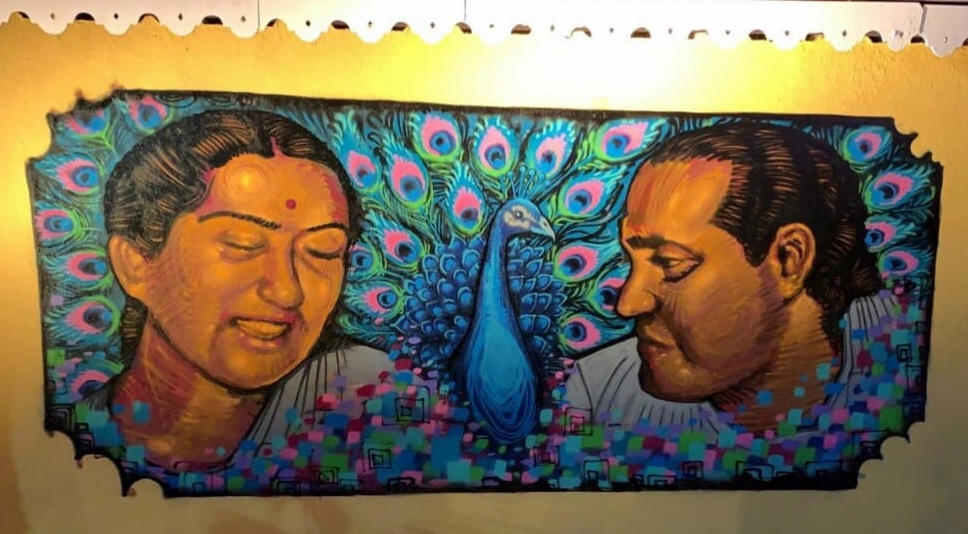
Location: Maquinez Palace / INOX, Panjim
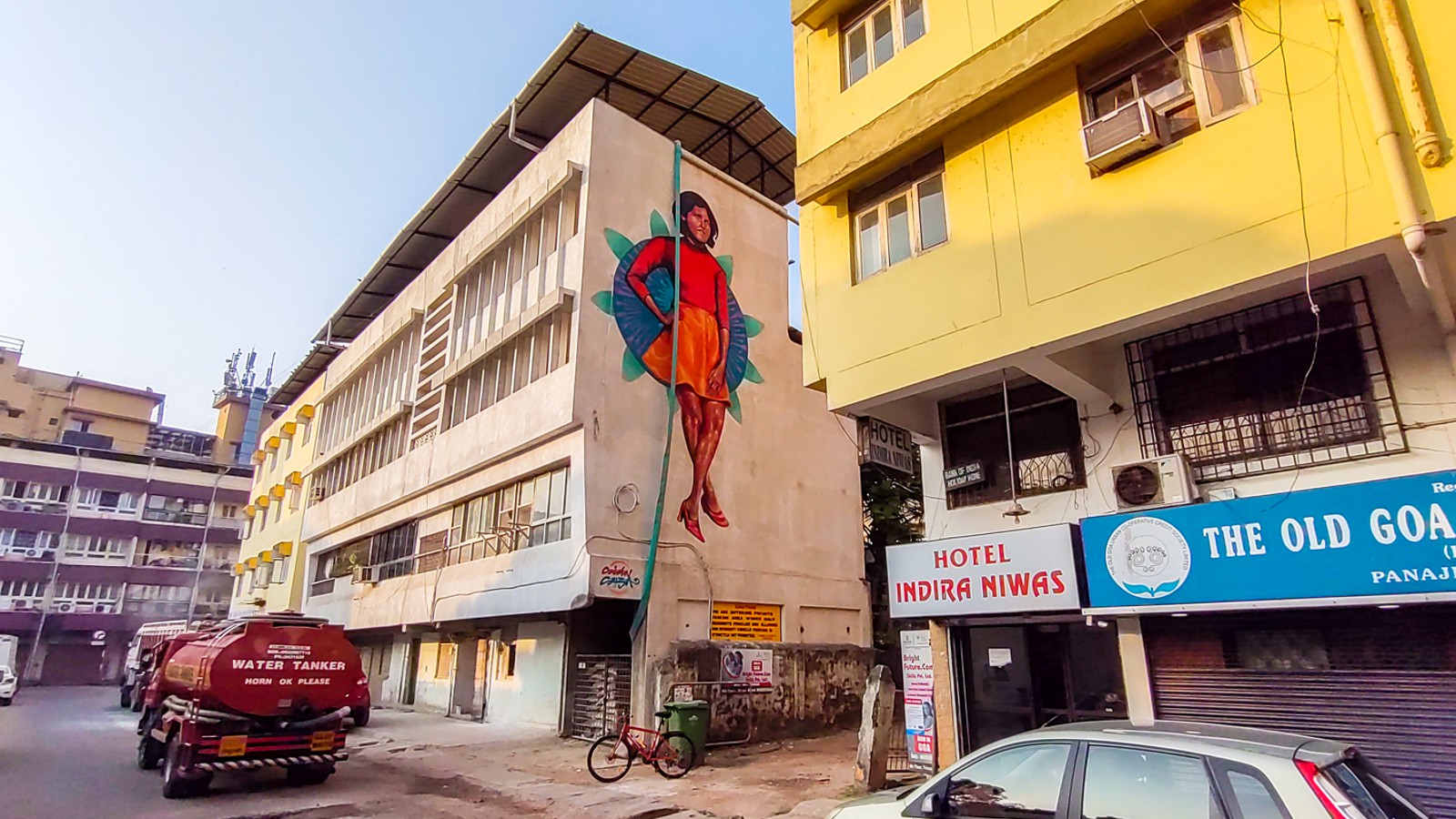
5. Sita Valles
The courageously daring anti-colonial revolutionary known as ‘Passionária’ de Angola’ (the tendrils of the passion flower can be seen in the background of this photograph) was a political activist, doctor, and member of the Portuguese Communist Party. Following the events of May 1977, she was tortured and brutally killed, most likely in August 1977 in Luanda, Angola.
D A Smith translated the Portuguese journalist Leonor Figueiredo about her execution at the age of 26, “the beautiful, elegant and intelligent communist of Goan origin — a Portuguese with an African heart — remained rebellious until the last moment. She said she was not afraid and that the sooner they killed her the better. By refusing to be blindfolded, she forced the snipers of the firing squad to meet her gaze before pulling the trigger.”
Read more: Sita Valles
Location: Krishna Kunj building, behind Walkover store, Panjim
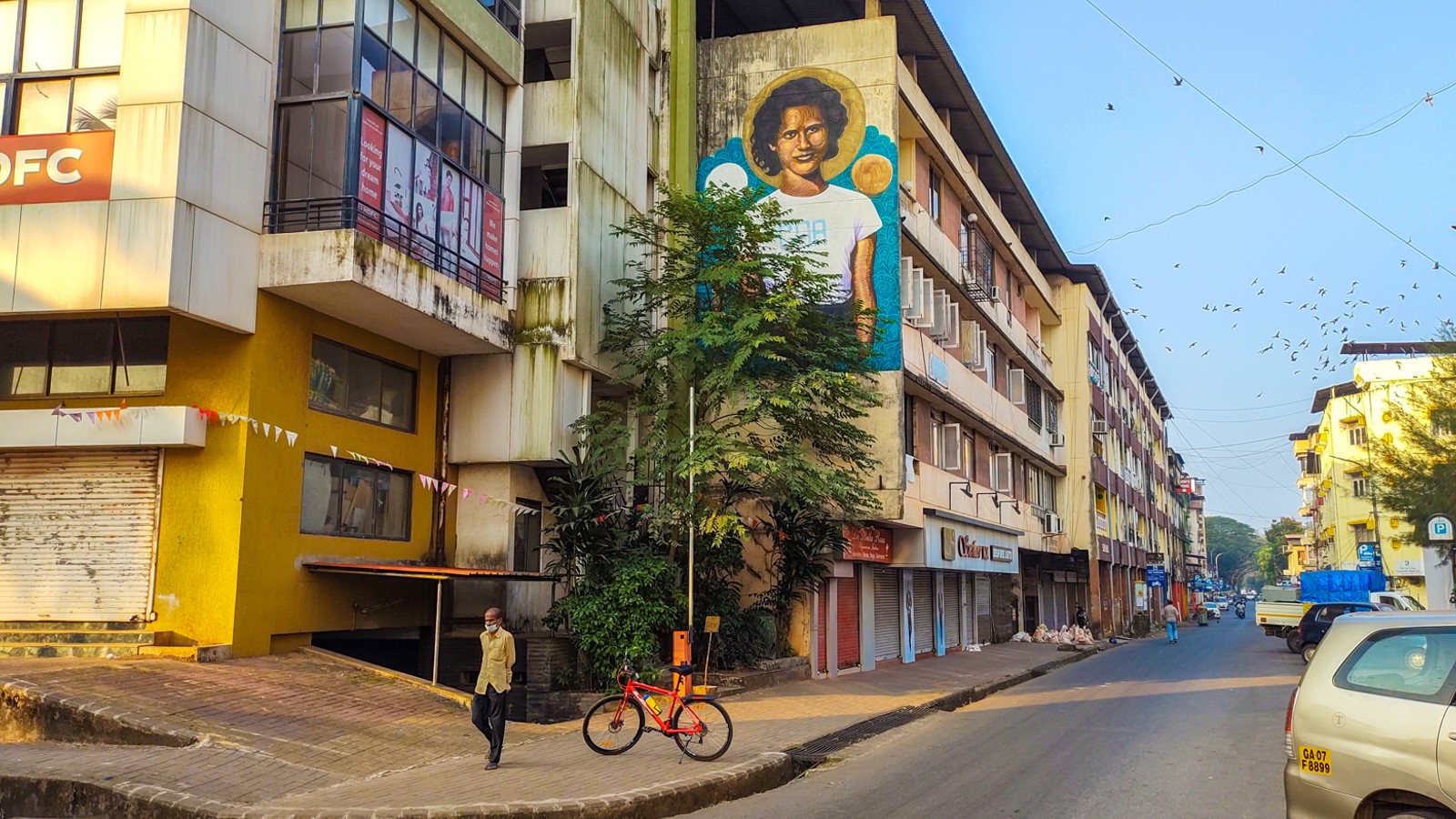
6. Mary D’Souza Sequeira
The first Indian to represent the country at the Olympics in two different sports – hockey and track and field. All through the 1950s, Sequeira held the Asian records for 100 and 200 meter sprints, winning gold + silver + bronze at the Asian Games in 1951 and 1954. This fastest woman across all the countries in this part of the world qualified for the 1956 Melbourne Olympics, but her country declined finance for women athletes. Sequeira was also the most prolific scorer on India’s very first women’s international field hockey teams, right into the 1960s.
Read more: Mary D’Souza Sequeira
Location: Seagull building, near Perfect Confectionery, Panjim
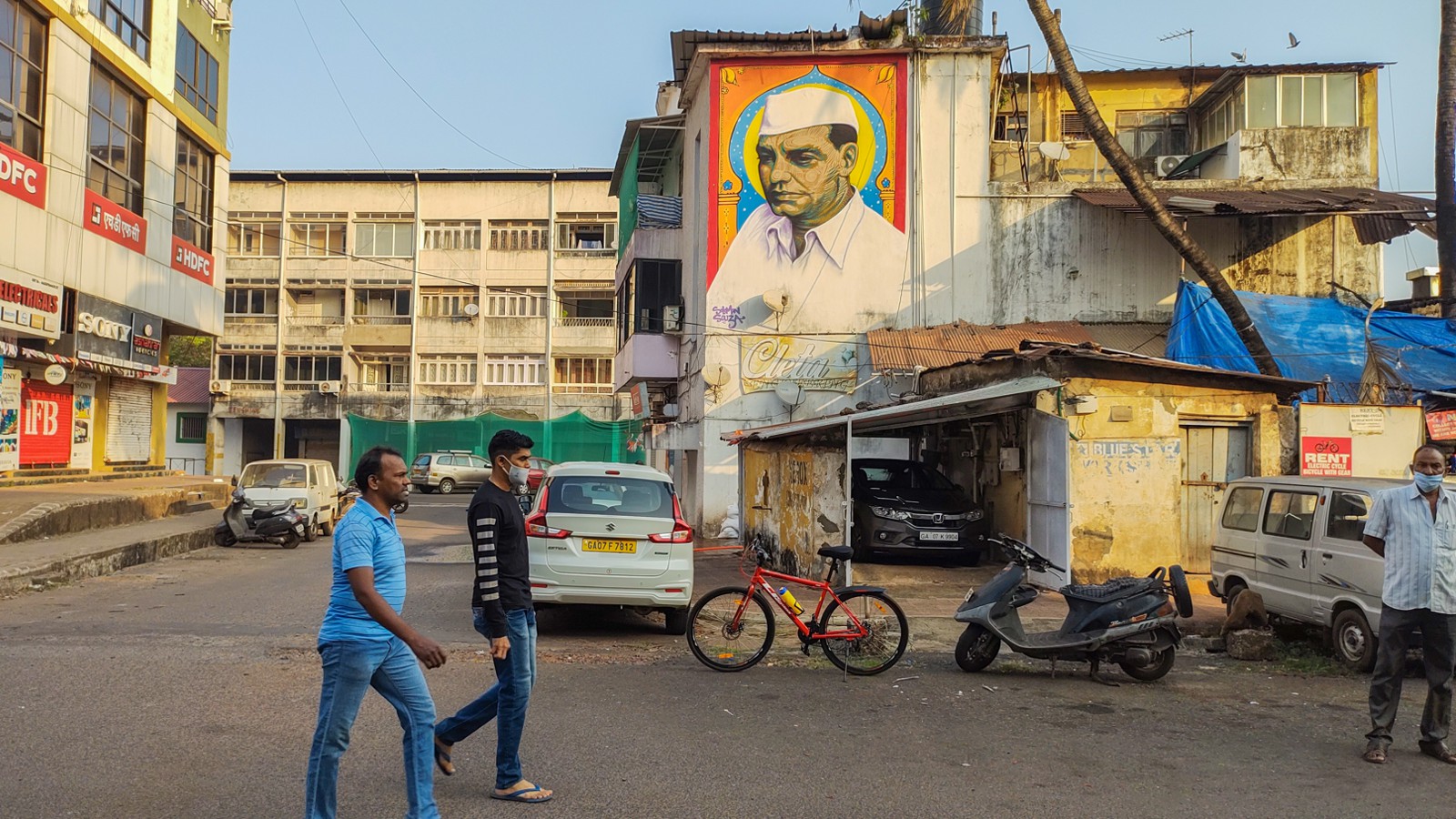
7. Angelo da Fonseca
Born in 1902, Fonseca was a prolific and versatile painter. A pioneer of India’s Christian Cultural Renaissance, he received harsh criticism for painting Christian themes in Indian settings. The priest in his hometown of St Estevam chastised him for painting the Virgin Mary in a traditional Goan Sari (Kunbi). He eventually left Goa and moved to Poona, where he practised at the Khrist Prem Seva Ashram and accomplished useful work.
Read more: Fonseca as retold by Yessonda / Angelo da Fonseca
Location: behind Geeta Bakery, Panjim
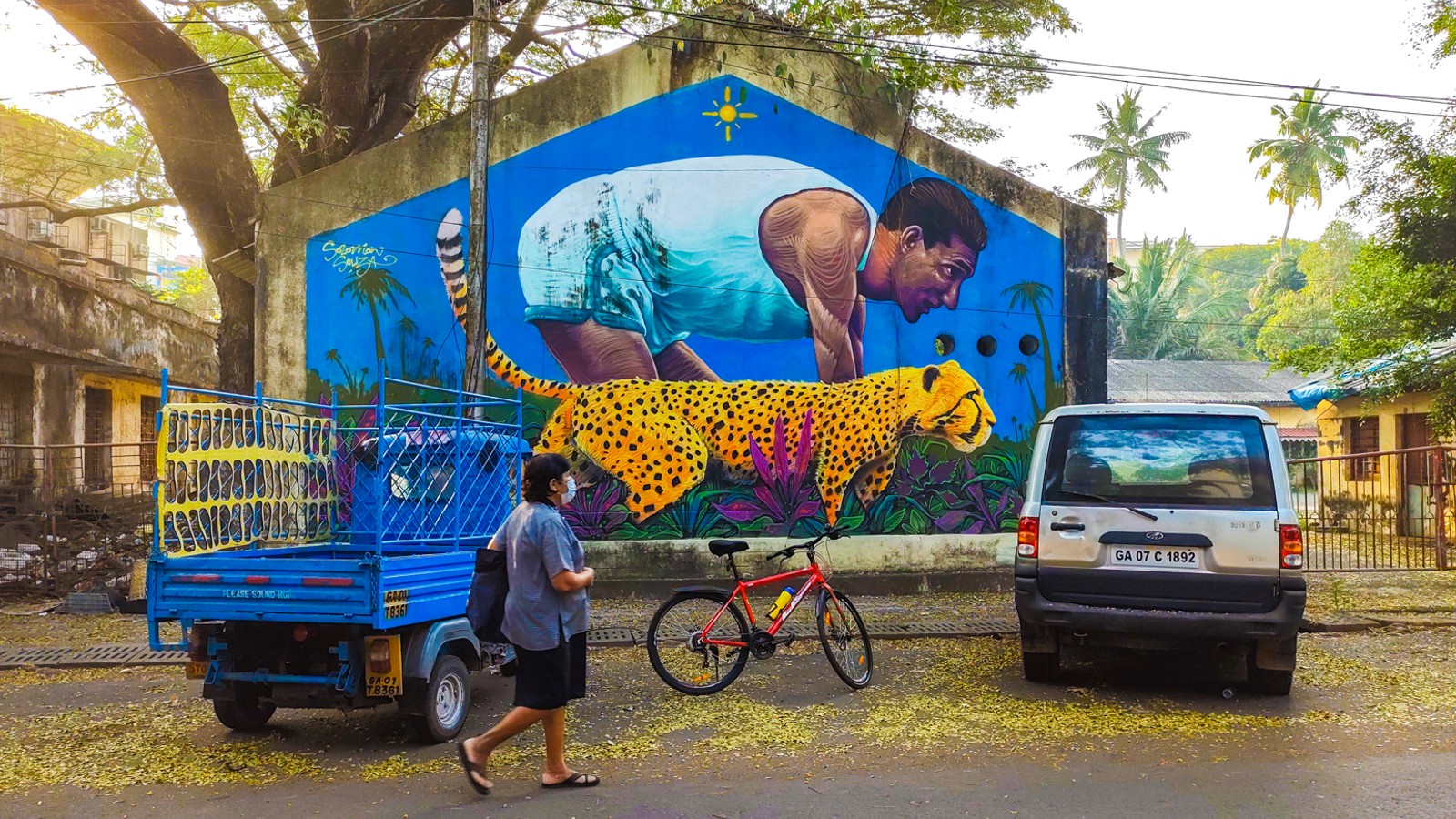
8. Seraphino Antao
On your marks… Get set… Go! Antao, often known as “the gazelle” or “the cheetah,” was a Kenyan sprinter of Goan origin who was born and raised in Mombasa, Kenya, his family’s roots can be traced back to the South Goa village of Chandor. He was one of the worlds fastest men for some years winning a double gold for Kenya in both the short sprints at the 1962 Commonwealth Games in Perth. No Kenyan or Indian has come close to that feat ever again. At the 1964 Tokyo Olympics he became Independent Kenya’s first Olympic flag bearer at the opening ceremony of the games.
Read more: Seraphino Antao
Location: next to Unique Gym, opp Don Bosco School, Panjim

9. Dilip Sardesai
The first Goan to play for India’s cricket team, Sardesai made his Test debut on 1 December, 1961 against England at the Feroze Shah Kotla stadium in New Delhi. He was introduced to then Prime Minister Jawaharlal Nehru as a “young man who hails from Goa”. Nehru said, “Ah, Goa! Don’t worry, the Indian army will soon liberate your state.” Just a few days later, on 19 December, Goa was liberated from Portuguese rule. Sardesai’s Indian cricket career, therefore, started approximately at the same time when his place of birth Goa became a part of the Indian union.
In his book ‘Democracy’s XI’ Rajdeep Sardesai recalls a story, told to him by Sunil Gavaskar himself, which sums up Sardesai’s role. “It was the first game of the tour, a side match against Jamaica. As the fast bowlers bowled five bouncers in the first over, Gavaskar and Vishwanath, the two rookies in the team, looked at each other and wondered how they would cope with such pace.
“My father was peering through the dressing room window, and let out an expletive in Marathi. ‘These are no bloody fast bowlers, the real pace was in 62 with Hall and Griffith, we will handle these popatwadi (a Marathi term for useless) bowlers easily.’ That was the moment, Gavaskar tells me, the mood in the dressing room changed from fear to confidence,” says Rajdeep.
Led by the performances of these two, India won that series 1-0, and it started a turnaround in its cricketing fortunes. For his role in that, one of India’s first cricketing greats, Vijay Merchant, termed Sardesai “the man responsible for the Renaissance of Indian cricket”.
The Goa Government has instituted the Dilip Sardesai Award that is presented every year to the leading sportsperson in the state.
Read more: https://en.wikipedia.org/wiki/Dilip_Sardesai
Location: Government Technical High School Centre, Panjim
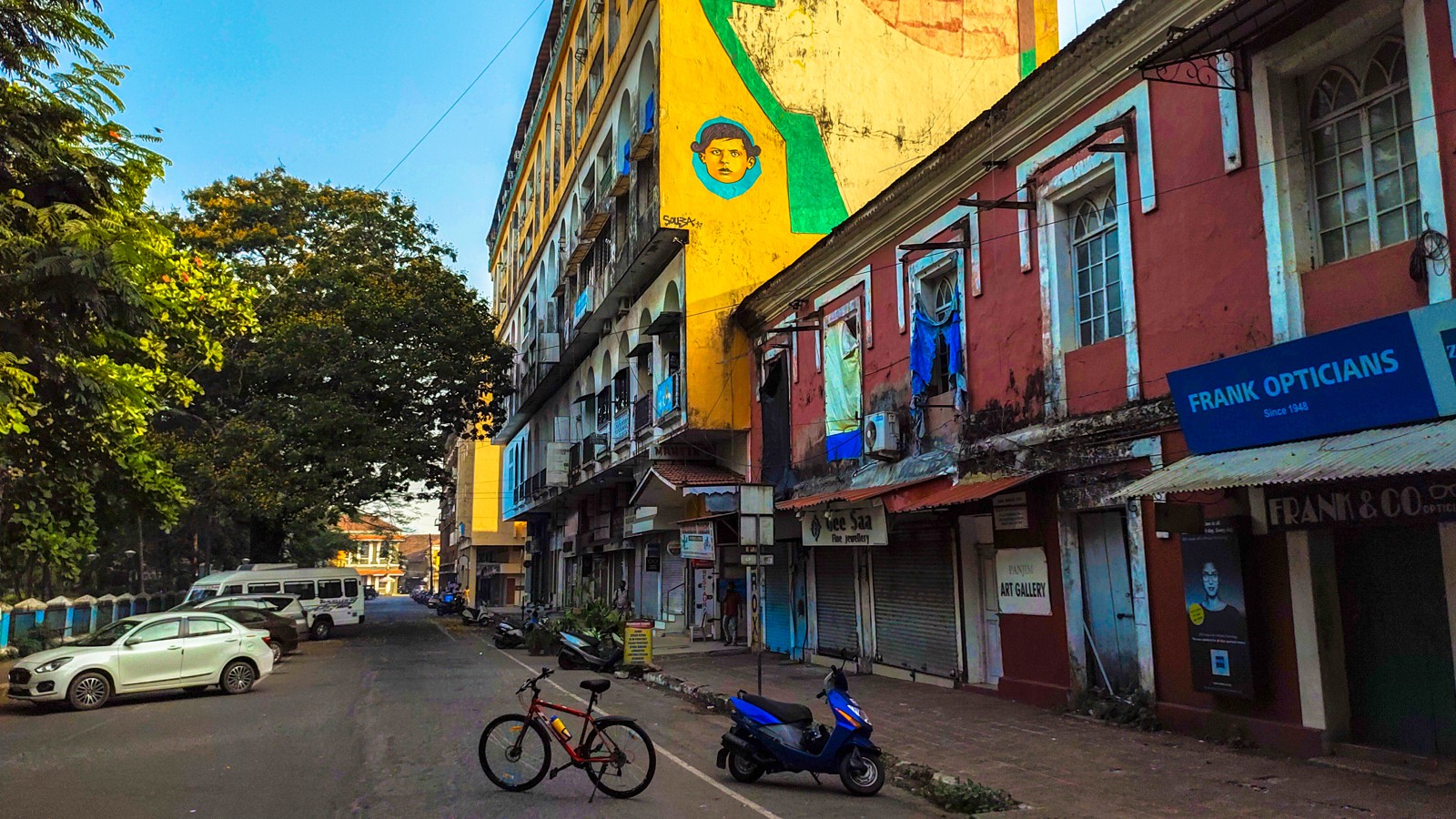
10. Francis Newton Souza as a child
Text copied from Solomon Souza’s Instagram post:
It is time for me to leave Goa… this enchanted land… this Narnia of an experience… i do so with a heavy heart. For the past month and a half i have immersed myself in its depths, soaking up every smile, every mango lassi, every puri baji, every cows twisted horn, every dogs crooked tail, every close call on these excitingly chaotic roads and of course the multitudes of incredible characters iv had the privilege to meet along the way, lifelong friends and not a single enemy… i am immensely grateful to the entire @serendipityartsfestival team and the masterful curator Vivek Menezes for not just inviting me, but guiding me, truly enabling me to reconnect with the land of my Grandfather…
We ended up painting more than 20 murals in here, paying homage to some of Goa’s greatest. Intending to finish with my Grandfather – FN Souza. We found the perfect wall and all was set to paint the great pioneer of the progressive arts… however, the universe had different plans and besides for the lift that showed up being only a fraction of the height needed to paint the huge wall we had chosen the police also decided to call me repeatedly, requesting my presence at the local station for questioning concerning my visa to which I eventually obliged and spent most of the day attempting to wriggle out of the hole i found myself in.
When I finally returned to the wall the driver of the lift told me i had only half an hour before he had to leave, so picking up my paint, alighting the work platform (with my friend @nigel_iverson) and extending the lift to its utmost extremity i attempted a token of gratitude to the man who had tied me to this life and legacy. I painted Souza as a child, the age he would have been whilst in Goa, a young thing with the world stretched out and open before him like the huge blank wall i was unable to paint.
When the driver finally coaxed me down off the lift i was at first upset that i had not completed the task i had come to do… but my faith and trust in the conductor of this conundrum we call life soon kicked in and it dawned on me that perhaps this was just beginning for young Souza and that one day, the entire wall would be his canvas.
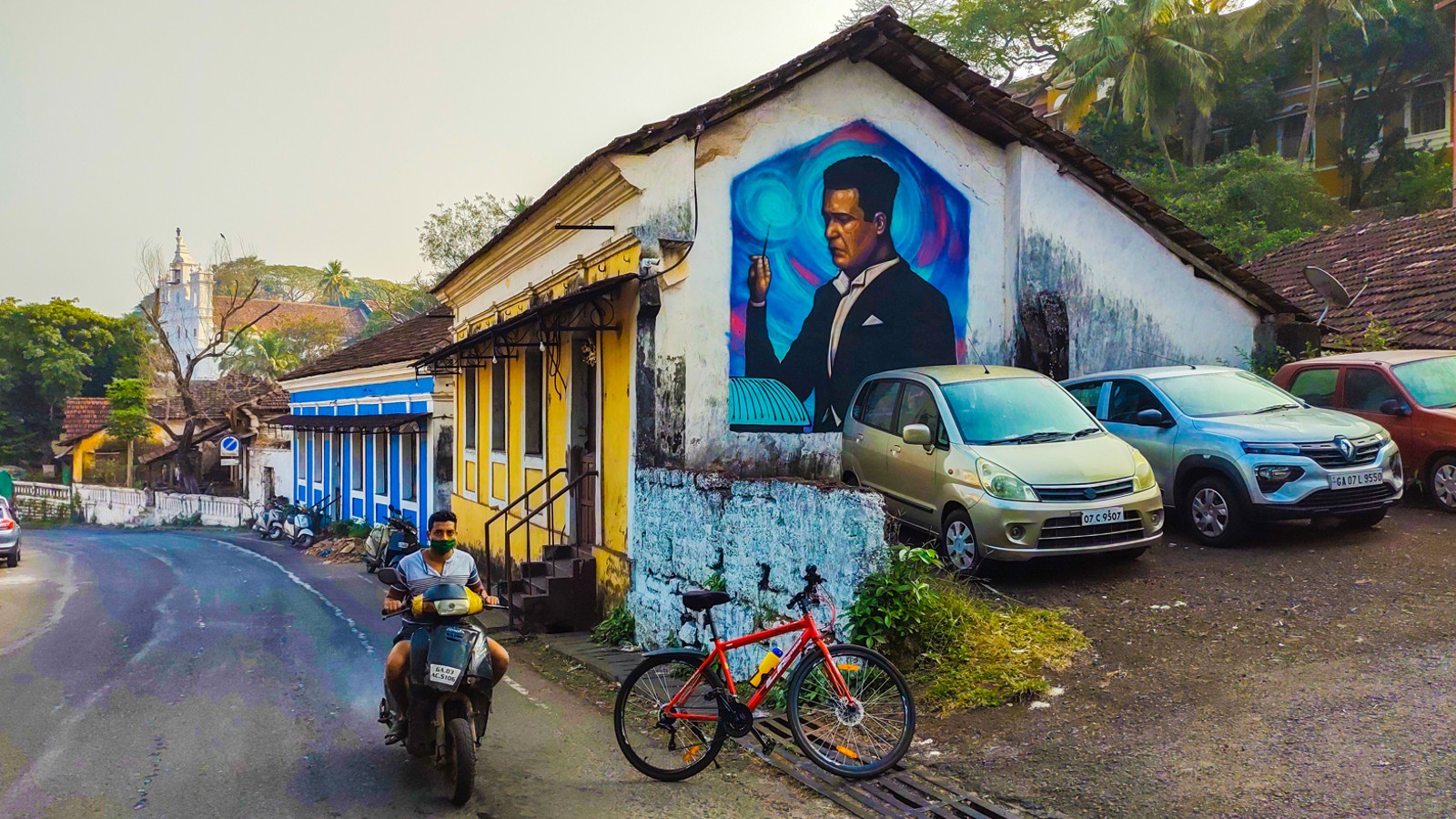
11. Maestro António Fortunato de Figueiredo
On the road up to Altinho, on the wall of his own home for many years, Solomon paid tribute to India’s very first conductor of western classical music, who trained at the National Conservatory of Lisbon, the Sorbonne, the National Conservatory of Music in Paris, and the Accademia Musicale Chigiana in Siena. He then founded the Goa Symphony Orchestra and the outstanding Academia de Música da Índia Portuguesa which seeded the Kala Academy’s division of western classical music education. Generations of Goan excellence in this field owe a great deal to this brilliant, hard-striving pioneer.
Read more: António Fortunato de Figueiredo
Location: Altinho, near Panjim Church.

12. Percival Noronha
Esteemed historian, raconteur, archivist, and astronomy enthusiast, this teacher to many, passed away last year aged 96. Noronha lived in the beautiful old quarter of Fontainhas, his home and study only a few steps from where this mural paying respects to him and his work is painted. Solomon has used many of the fascinating motifs and designs that can be found throughout his neighborhood as a frame for his portrait, so that he may live on amongst the enchanting old houses he so dearly loved.
Read more: Percival Noronha – a fine human being with a repository of everything Goan.
Location: Opp Indian Overseas Bank, Panjim

13. Vishnu Surya Wagh
Poet, writer, theatre personality, journalist and flamboyant politician who courted controversies, Wagh was elected to the Assembly for the first time in 2012 from St. Andre constituency of North Goa on a BJP ticket. ‘Sudhir Sukta’ (Song of the Sudhirs), a scorching collection of poetry by Wagh, was the subject of significant controversy in 2017 due to its language and substance.
Read more: Vishnu Wagh
Location: Opp SOHO, Patto Colony, Panjim

14. Sonia Shirsat
Painted on the red wall of the DTR restaurant is the Queen of Goan Fado, also referred to as “the ambassador of Goan music to the world”, Sonia has performed across India and the world.
Read more: Queen of Fado Sonia Shirsat / Sonia Shirsat
Location: Below DTR restaurant, Panjim
In Panjim, I began my hunt for Icons by photographing the mural of Brahmanand soaring through the air to stop a goal and ended up seeing Sonia perform another legendary Fado.
Saligao is the next stop.
I took the Verem, Pilerne Industrial Estate to Saligao route after crossing the Panjim – Betim ferry, a distance of 9.8 kilometres, to discover the four paintings of Saligaocars. The Saligao Institute is the first stop.
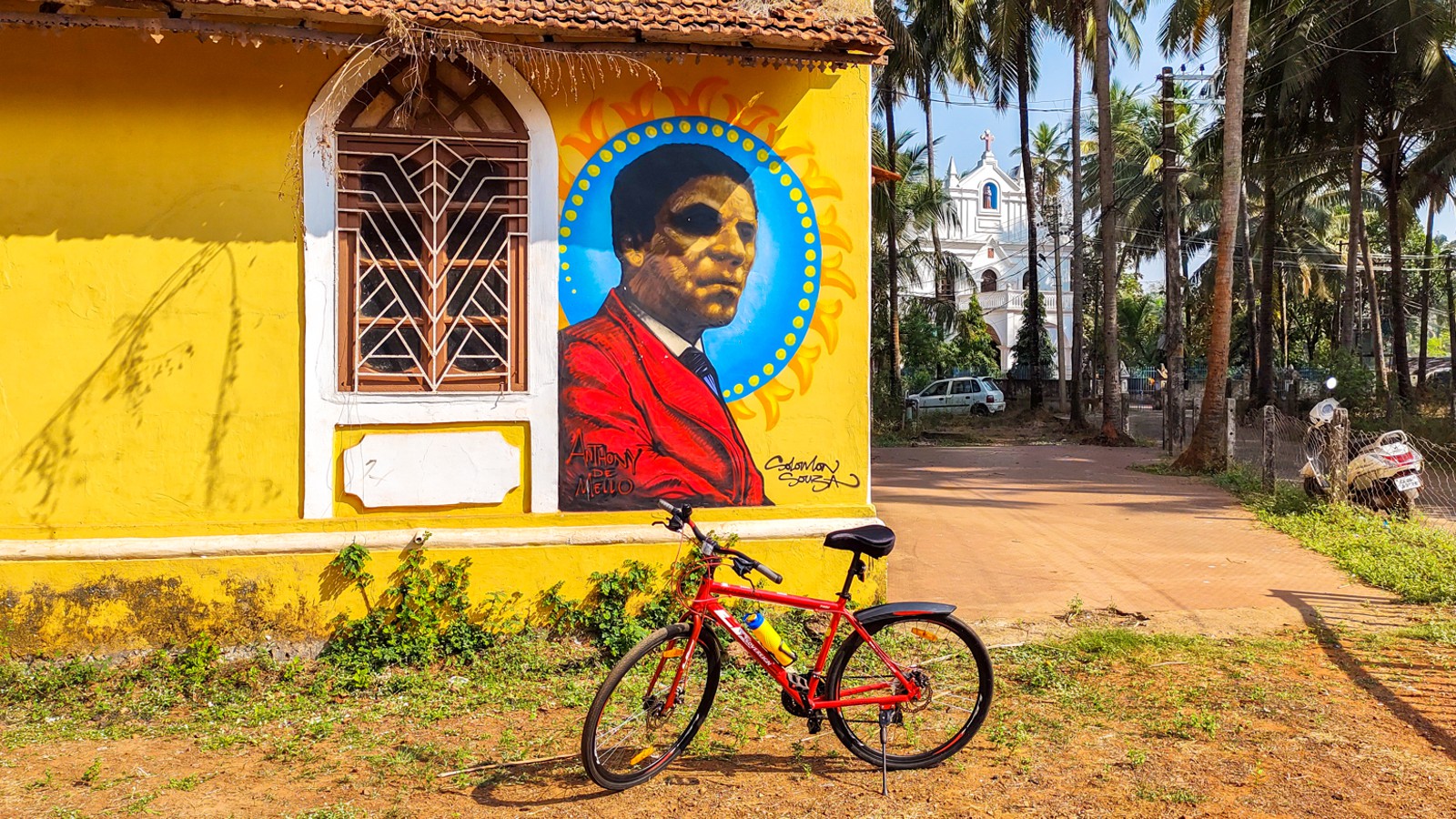
15. Anthony de Mello
“A colossus of a man” de Mello was born in Karachi and educated at Cambridge, this pioneering Goan’s ambition and persistence drove him to unprecedented heights. It was said of him that if he promised you the Empire State Building, you would be sure of one thing; he would move heaven and earth to fulfil it. He played the leading role in the formation of the BCCI and the CCI. It was through his untiring efforts that the National Cricket Championship of India for the Ranji Trophy was born.
Read more: Anthony de Mello
Location: Saligao Institute
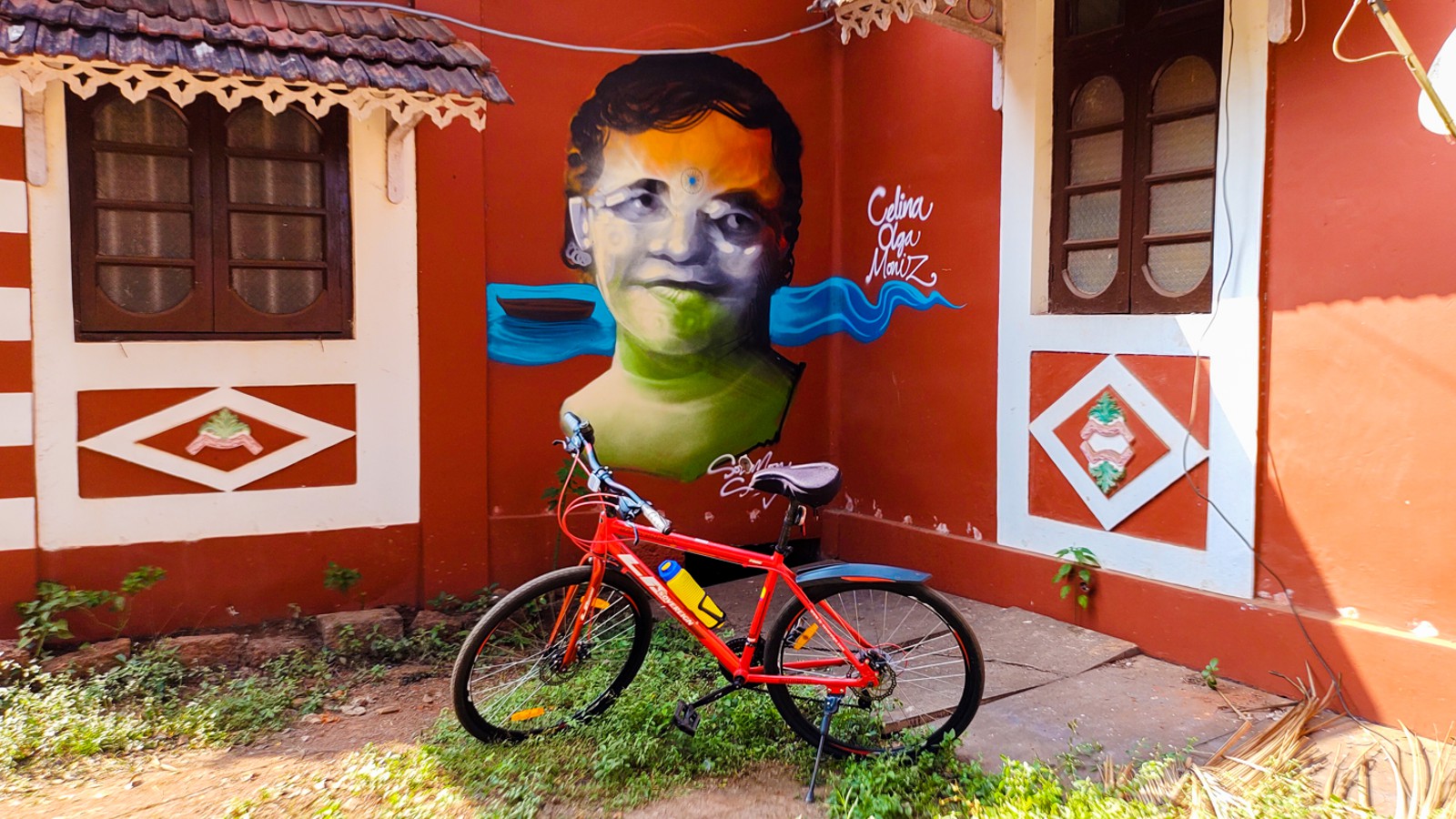
16. Celina Olga Moniz
Arrested on January 26, 1955, for carrying the Tricolour, she was severely tortured at the Panaji jail and was released only in October of the year. She is known to have helped the underground nationalist movement in Goa and neighbouring states to provide support and financial assistance for the movement. Most of her associates, who were involved with the original planning of Goa’s freedom struggle at a meeting held at the residence of Dr Jose Francisco Martins in June 1954, were arrested and tried at the military court. Moniz is the recipient of Tamrapatra from the central government, one of the highest honours for political prisoners.
Location: near Saligao Institute

17. Eunice de Souza
“Learn from the almond leaf which flames as it falls.
The ground is burning. The earth is burning.
Flamboyance is all.”
A cherished poet of India, responsible for inspiring and uplifting a whole nation of keen literary minds within India and the world in general. As it turns out this warrior woman, armed with her pen, paper and razor sharp tongue was a daughter of the village of Saligao. Amongst countless other achievements, She held the position of head of the English department at St. Xaviers college in Mumbai for many years until her retirement and helped nurture generations of writers there, instilling within them the global ambition and communicative skills that runs true through the veins of so many Goans.
Location: next to Hair Cut Salon, Saligao
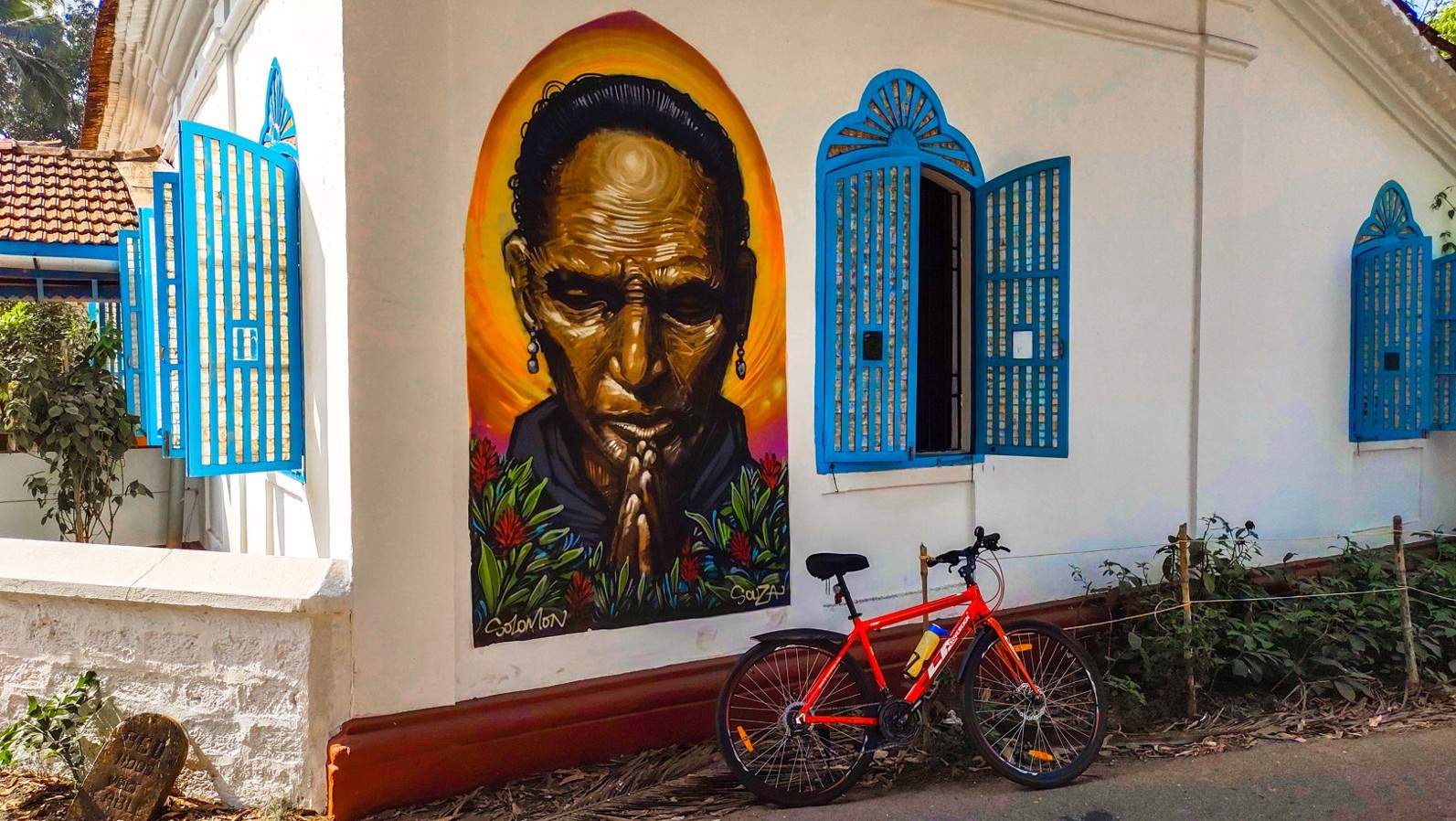
18. Sacrula
The first mural Solomon painted for the “Icons of Goa” project was this one. He chose to portray the figure of a real Goan legend, Sacrula, a mysterious person who could at one time be seen wandering the winding lanes of the town of Saligao, performing magic tricks, telling tales, and bestowing blessings on anyone who crossed his path! He was a beloved character of the area, who brought much joy and happiness to everyone.
Location: Heta Pandit’s house, Saligao
18 murals seen, 2 left, on to Aldona, via Parra, Guirim, Bastora, Uccasaim, Nachinola. Distance 13.8kms.

19: Chic Chocolate (Antonio Xavier Vaz 1916-1967)
A revered jazz master who was known as the “Louis Armstrong of India” was born in Aldona. He learned music at his local parochial school and, despite the wishes of his mother who wanted him to earn a “respectable” living as a mechanic, he followed his dreams of a life playing music. Chocolate was heavily influenced by Louis and African American music in general and used his dramatic performances to develop a unique taste of Indian Jazz, scatting and trumpeting his way all over the country and into the hearts of so many.
Read more: Chic Chocolate
Location: Aldona Institute

20. Vamona Navelcar
An artist who has lived and worked in three continents and a master of line drawing whose inspirations range from poetry to Christian art though his work is classically secular, Vamona Navelcar whose roots lie in the sleepy village of Pomburpa, studied art in Portugal in the 1950s, taught geometry in Mozambique, and then moved back to Portugal and, finally, to Goa. His art reflects the socio-political climate of all these three places. He adopted the name of “Ganesh”, after an incident that caused him to be “reborn” (Lord Ganesh is associated with new beginnings) and in memory of his brother Ganesh.
Read more: Vamona Navelcar
https://www.pruthagoa.com/vamonanavelcar
Location: near the Pomburpa ferry jetty
The last on the route was the mural of Vamona Navelcar near the Pomburpa ferry jetty. 4.9kms from the Aldona Institute. The ride back to Taleigao was along the Mandovi river bank through the villages of Pomburpa, Salvador do Mundo, Penha de França, the Betim – Panjim ferry to Campal and Miramar – distance 15.7kms.
Murals seen 20 | Distance cycled 62.88kms | Time 05:15:14 hours
PS: Some text copied from the social media posts of Solomon Souza and Vivek Menezes.
